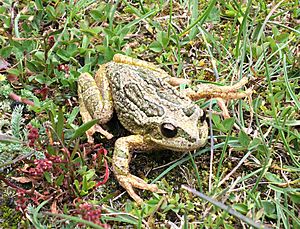Peru marsupial frog facts for kids
Quick facts for kids Peru marsupial frog |
|
|---|---|
 |
|
| Conservation status | |
| Scientific classification |
The Peru marsupial frog (Gastrotheca peruana) is a special kind of frog that lives only in Peru. It's part of the Hemiphractidae family of frogs. When we say it's "endemic" to Peru, it means you won't find this frog naturally anywhere else in the world!
These frogs live in many different places. You can find them in high-up grasslands, near rivers, and in wet areas like marshes. They can even live near farms, in gardens, and sometimes in urban areas where people live.
Some people keep the Peru marsupial frog as a pet. It has been seen in the pet trade, for example, in Germany. However, this hasn't caused a big problem for the frog's population in the wild.
Contents
What is a Marsupial Frog?
The Peru marsupial frog gets its name from a special way it carries its eggs. Just like a kangaroo carries its baby in a pouch, the female marsupial frog has a pouch on her back. This pouch is where she keeps her eggs safe until they are ready to hatch. It's a very unique way for a frog to protect its young!
Where Do They Live?
The Peru marsupial frog lives in the country of Peru, which is in South America. They prefer places that are high up, often in the Andes Mountains.
Their homes, or habitats, include:
- High-altitude grasslands: These are open areas with lots of grass, often found in mountains.
- Rivers and marshes: Wet areas near water are perfect for frogs.
- Farm lands: Sometimes they live near arable land (where crops are grown) and pastureland (where animals graze).
- Gardens and urban areas: They can even adapt to living near people.
Appearance and Size
The Peru marsupial frog is a medium-sized frog. Like other frogs, it has smooth, moist skin and strong legs for jumping. Its color can help it blend in with its surroundings, which keeps it safe from predators.
Life Cycle and Reproduction
The most interesting part of the Peru marsupial frog's life is how it reproduces. Instead of laying eggs in water like many frogs, the female carries her eggs in a special pouch on her back.
- The male frog helps place the fertilized eggs into the female's pouch.
- The eggs stay safe and develop inside this pouch.
- Depending on the species, the eggs might hatch into tiny tadpoles that then swim out, or they might develop directly into small froglets that hop out of the pouch! This protects them from dangers in the water.
Conservation Status
The Peru marsupial frog is currently listed as "Least Concern" by the International Union for Conservation of Nature (IUCN). This means that, for now, its population is stable and it's not considered to be in danger of disappearing. However, it's always important to protect their habitats to make sure they continue to thrive.
See also
 In Spanish: Gastrotheca peruana para niños
In Spanish: Gastrotheca peruana para niños


